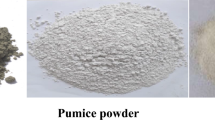Abstract
This paper presents the use of Ferrochrome powder (FP) as a supplementary cementitious material replacing a part of ordinary Portland cement (OPC). Ferrochrome powder is a flue dust generated in the ferrochrome industry. OPC was replaced by FD 0–40% at an interval of 10%. The mechanical properties like compressive strength, split tensile strength and flexural strength were examined at 7, 28, 56 and 91 days. The results revealed that there was a decline of property values on the supplementation of FP. The strength parameters like compressive, split tensile and flexural strength almost reduced by 25% on replacement of 40% when examined at the age of 28 days. The normal concrete mix offered the strength of nearly 39 MPa at 28 days, whereas the mix with 40% FP content offered nearly 29 MPa. From the trend of results, it is observed though there is a reduction in strength due to supplementation of FP, still may be considered beneficial from a waste utilization economy point of view. Saving 40% cement due to supplementation of FP, thereby losing 25% strength and achieving strength of 29 MPa can also be considered important from the circular economy point of view. A mix of concrete achieving 29 MPa at 28 days can be used for some normal strength structural components.
Access this chapter
Tax calculation will be finalised at checkout
Purchases are for personal use only
Similar content being viewed by others
References
Sanjuan MA, Andrade C, Mora P, Zarogoza A (2020) Carbon dioxide uptake by cement based materials: a Spanish case study. Appl Sci 10:339. https://doi.org/10.3390/app10010339
Snehal K, Das BB, Kumar S (2020) Influence of integration of phase change materials on hydration and microstructure properties of nano silica admixed cementitious mortar. J Mater Civil Eng ASCE 32(6)
Snehal K, Das BB, Akanksha M (2020) Early age, hydration, mechanical and microstructure properties of nano-silica blended cementitious composites. Constr Build Mater Elsevier 233
Snehal K, Das BB (2019) Techniques for preparation and dispersion of nano-SiO2 in cementitious system—a review. In: Select proceedings of ICSCBM 2018. Springer, pp 397–407
Snehal K, Das BB (2021) Experimental set-up for thermal performance study of phase change material admixed cement composites—a review. In: Select proceedings of SMTS 2019. Springer pp 137–149
Snehal K, Das BB (2020) Application of Andreassen and modified Andreassen model on cementitious mixture design: a review. In: Select proceedings of ICRDSI 2019. Springer, pp 729–750
Snehal K, Das BB (2021) Influence of incorporating phase change materials on cementitious system—a review. In: Select proceedings of TMSF 2019. Springer, pp 33–63
Das BB, Snehal K (2018) Engineering properties of nano-particles admixed concrete—a review. In: Advances in concrete, structural and geotechnical engineering. Bloomsbury Publishing Plc, pp 190–195
Sanjuan MA, Argiz C, Mora P, Zarogoza A (2020) Carbon dioxide uptake in road map 2050 of the Spanish cement industry. Energies 10:3452. https://doi.org/10.3390/en13133452
Renjith R, Shivaprasad KN, Das BB (2018) Properties of heat cured bottom ash based geopolymer mortar admixed with fly ash of different fineness. In: Advances in concrete, structural and geotechnical engineering. Bloomsbury Publishing Plc, pp 603–607
Goudar SK, Shivaprasad KN, Das BB (2019) Mechanical properties of fiber reinforced concrete using coal-bottom ash as replacement of fine aggregate. In: Select proceedings of ICSCBM 2018. Springer, pp 863–872
Goudar SK, Das BB (2021) Influence of particle size of bottom ash on mechanical properties of M30 grade concrete. In: Select proceedings of TMSF 2019. Springer, pp 533–543
Chethan Kumar B, Yaragal S, Das BB (2020) Ferrochrome ash—its usage potential in alkali activated slag mortars. J Clean Prod 257
Mohanty T, Majhi S, Saha P, Das B (2019) Combined effect of fly-ash and ferrochrome ash as partial replacement of cement on mechanical properties of concrete. In: E3S web of conferences, CGEEE 2018. https://doi.org/10.1051/e3sconf/20199302008
Dattani KR, Bhuva PK, Borad CV (2017) Performance of ferrochrome ash (FCA) with lime as partial replacement of cement in self compacted concrete. J Emerg Technol Innov Res 4(4):269–277
Mohanty T, Saha S, Saha P, Das B (2019) Structural behaviour of concrete with fly-ash and ferrochrome ash as partial replacement of cement. Int J Rec Technol Eng 8(4):11086–11091
Mohanty S, Parhi PK (2017) Impact of ferrochrome ash and gypsum powder on properties of concrete. Int J Eng Res Technol 6. https://doi.org/10.17577/IJERTV6IS070016
Rao DS, Angadi SI, Muduli SD, Nayak BD (2010) Valuable waste. Mineral processing, English Edition, vol 51, pp 2–6
Acharya PK, Patro SK (2015) Effect of lime and ferrochrome ash (FA) as partial replacement of cement on strength, ultrasonic pulse velocity and permeability of concrete. Constr Build Mater 94:448–457
Acharya PK, Patro SK (2016) 457Acid resistance, sulphate resistance and strength properties of concrete containing ferrochrome ash (FA) and lime. Constr Build Mater 120:241–250
Acharya PK, Patro SK (2016) Strength, sorption and abrasion characteristics of concrete using ferrochrome ash (FCA) and lime as partial replacement of cement. Cement Concr Compos 24:16–25
Acharya PK, Patro SK (2016) Use of ferrochrome ash (FCA) and lime dust in concrete preparation. J Clean Prod. https://doi.org/10.1016/j.jclepro.2016.05.042
Author information
Authors and Affiliations
Editor information
Editors and Affiliations
Rights and permissions
Copyright information
© 2022 The Author(s), under exclusive license to Springer Nature Singapore Pte Ltd.
About this chapter
Cite this chapter
Pani, A.K., Acharya, P.K., Tripathy, J. (2022). Ferrochrome Powder as a Partial Replacement of Cement. In: Das, B.B., Gomez, C.P., Mohapatra, B.G. (eds) Recent Developments in Sustainable Infrastructure (ICRDSI-2020)—Structure and Construction Management. Lecture Notes in Civil Engineering, vol 221. Springer, Singapore. https://doi.org/10.1007/978-981-16-8433-3_68
Download citation
DOI: https://doi.org/10.1007/978-981-16-8433-3_68
Published:
Publisher Name: Springer, Singapore
Print ISBN: 978-981-16-8432-6
Online ISBN: 978-981-16-8433-3
eBook Packages: EngineeringEngineering (R0)




